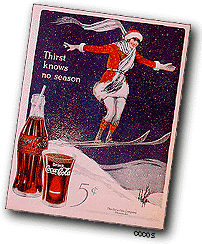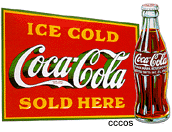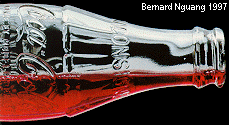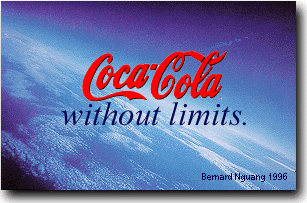The Chanler Era
On may 1, 1889, Asa Candler published a full page advertisement in the Atlanta Journal, proclaiming his wholesale and retail drug business as "sole proprietors of Coca-Cola.....Delicious. Refreshing. Exhilarating. Invigorating." Sole ownership, which Chandler did not actually achieve until 1891, cost him a total of $2,300.
Chandler had a flair for merchandising, and by 1892, sales of Coca-Cola syrup had increased nearly tenfold. He soon disposed of his pharmaceutical business to devote full time to the soft drink. With his brother, Attorney John S. Chandler, John Pemberton’s former partner, Chandler formed a Georgia corporation named the Coca-Cola Company, with capital stock of $100,000.
While Chandler's efforts focused on boosting soda fountain sales, other ideas were developing that would spread the enjoyment of Coca-Cola worldwide. In 1894, in Vicksburg, Mississippi, Joseph A. Biedenmharn was so impressed by the growing demand for Coca-Cola at his soda fountain that he installed bottling machinery in the rear of his store and began to take bottles of Coca-cola to plantations and lumber camps up and down the Mississippi River. As a result in, using syrup shipped from Atlanta, he became the first to put Coca-Cola in bottles. this innovation created a new marketing concept and opened the way to wider distribution of Coca-Cola.
The first bottling plant under the new contract was opened in Chattanooga in 1899 and the second in Atlanta the following year. By then, realising they could not raise enough capital to build bottling operations nationwide, Thomas, Whitehead and Lupton decided to seek out local capital. They contacted with competent individuals to establish community bottling operations and in the return, the new partners received defined geographic areas in which to develop markets for Coca-Cola.
In the next 20 years, the first two plants increased to over 1,000, with 95 percent locally owned and operated. As the business grew, development of high speed bottling machinery and increasingly efficient transportation enabled bottlers to serve more customers with more products. today, about 1,400 bottlers serve consumers worldwide, forming an effective and vital part of the modern Coca-Cola system.
A Man named Woodruff
In 1919, The Coca-Cola Company was sold by the Chandler interests to Atlanta banker Ernest Woodruff and an investor group he had organised. The sale price was $25 million. Soon, the business was incorporated as a Delaware corporation, and its common stock was sold publicly for $40 per share.
Four years later, Robert Winship Woodruff was elected president of the Company, beginning more than six decades of active leadership in the business. The vigorous, 33-year-old Georgian had risen from truck salesman to vice president and general manager of White Motor Company before he joined the soft drink firm's Board of Directors.
The president put new major emphasis on product quality. he established a "QualityDrink" campaign with a staff of high trained servicemen to encourage and assist fountain outlets in aggressively selling and correctly serving Coca-Cola. Advertising and marketing support were increased substantially for the bottle business, in which Woodruff saw vast potential. By the end of 1928, the sales of Coca-Cola in bottles for the first time exceeded sales at fountains.
In 1929, the cartoon was joined by another revolutionary merchandiser-the metal, open-top cooler to serve Coca-Cola ice cold in retail outlets.
Robert Woodruff envisioned Coca-Cola as an international institution. Working with talented associates, his leadership set the momentum that has carried Coca-Cola to every corner of the world. The same year, Cuba and Puerto Rico were introduced to the softdrink and it wasn't long before the international distribution of syrup began. Through the early 1900s, bottling operations were built in Cuba, Panama, Puerto Rico, the Philippine and Guam. In 1920, a bottling company began operating in France- The first on the European continent. In 1926, Woodruff committed the Company to organised international expansion by establishing the Foreign Department.
Coca-Cola and the Olympics began their association in the summer of 1928, when an American freighter arrived in Amsterdam harbour carrying the United States Olympic team and 1,000 cases of Coca-Cola. Forty thousand spectators filled the stadium to witness two firsts- the first was lighting of the Olympic flame and the first sale of Coke at an Olympiad.
In 1985, the Company initiated a new era in its Olympic partnership, becoming the first sponsor of the International Olympic Committee under a new plan called the Olympic Program (TOP).
A Symbol of Friendship
At the outbreak of World War II, Coca-Cola was bottled in 44 countries worldwide, including those on both sides of the conflict. But instead of devastating the Coca-Cola business, the war only made the entire Coca-Cola system more determined to succeed than ever before.
The effort to supply the armed forces with Coke already was being launched by an elite group of employees when an urgent cablegram was sent from General Dwight Eisenhower's Allied Headquarters in North America.
Advertising for All Times
It is unlikely that any commercial slogan will ever create the lasting impact of "The Pause that Refreshes," which appeared first in The Saturday Evening Post in February 1929. It was the descendant of a long line of memorable slogans that have captured the public's fancy- beginning with the oldest, Dr. Pemberton's "Delicious and Refreshing" in 1886. "Thirst Knows No Season" in 1922, "It Had To Be Good To Get Where It Is" in 1925 and "Around The Corner From Anywhere" in 1927 solidified the universal, year-round appear of Coca-Cola.
Many more brilliant slogans followed, often echoing the refreshing idea: "It's The Refreshing Thing To Do"- in 1936, "Global High Sign"- in 1944, "Sign Of Good Taste"- 1957, "Be Really Refreshed"- 1959. The highly successful "Things Go Better With Coke" introduced an easy-going feeling in 1963.
"It The Real Thing", first used in 1942, was revived in 1969 to support a whole new merchandising stance for the product. In 1971, young people from around the world gathered on a hilltop to sing "I'd like to buy the world a Coke, a counterpoint to turbulent time.
In 1976, the reminder that "Coke Adds Life" was introduced. It became the foundation of "Have a Coke and a Smile," a 1979 campaign of immense popularity resulting from a series of television commercials including the heartwarming spot with 260-pound tackle "Mean" Joe Greene of the Pittsburg Steelers football team.
In early 1982, the theme "Coke is it!" was launched the reflect the resurging, positive spirit of the 1980s and to reaffirm the leadership of Coca-Cola. In 1986, a two-pronged campaign was unveiled with the theme "Catch the wave" for the modern, upbeat image of Coca-Cola and "Red, White & You," reflecting comsumers’ deep feelings for and identification with the taste of Coca-Cola classic.

Through the years, advertising for Coca-Cola has followed the trends of the times, whatever the era, while the overall theme always has been refreshment. Coca-Cola is and had been one of the pleasant things of life, distinctive and acceptable anywhere.
Fine illustrations by top artists including Norman Rockwell where the hallmark of colourful adds that projected the image of the drink's quality in leading magazines during the first half of the 20th century. Noted artist Haddon Sundblom's work even helped mold the nation concept of Santa Claus through his popular "portraits" for holiday ads, which began in the 1930s.
Nationwide use of billboards began in 1925 with the appearance of the famous bellhop serving Coca-Cola and the message "6,000,000 a day". The first large electrical signs, called spectaculars, also began to illuminate the crossroads of the world from London's Piccadilly Circus to Tokyo's Ginza to New York’s Times Square with an indelible and pleasant reminder of Coca-Cola.
Since the mid-1920s, radio has been an important medium of communication and continues to be a large segment of merchandising mix for Coca-Cola. In 1950, Edgar Bergan and his sidekick, Charlie McCarthy, appeared on Thanksgiving Day on the first live television network show sponsored by The Coca-Cola Company. Use of the powerful medium of television has grown in importance and effectiveness.
In point-of-sale advertising for millions of outlets worldwide, Coke unsurpassed. The quality and quantity of materials designed to identify availability and to assist the dealer in selling product have expanded and improved year after year.
By presenting an international unified theme in many languages, with locally orientated interpretations, Coke has remained native wherever it is.
More Choices for More Consumers
Until the mid-1950's, the world of Coca-Cola was defined by a 6 1/2-ounce hobble-skirt bottle or bell-shaped fountain glass. But the world began to change as new consumer habits dictated a wider variety of choices, and Company responded with innovative packaging, new technology and popular new products.
As their lifestyles grew more active, consumers wanted their soft drinks in containers that were larger, more convenient and more mobile. Metal cans for Coca-Cola were first developed for the armed forces overseas, and by 1960, civilian consumers began to see Coke in 12-ounce flat top cans on their market shelves. The Coca-Cola Company led the industry with the introduction of P.E.T. (Polyethylene Terephthalate) bottles for its products. Today, Company soft drink products are sold in a wide array of packages and package sizes, continuing to offer consumers the quality, convenience and value they have to come to expect from The Coca-Cola Company.
In addition to new ways to enjoy their favourite soft drink, consumers also have looked for new tastes to satisfy their refreshment needs, and the Company has responded with a range of successful products. First, in 1960, the Fanta family of flavoured soft drinks reached national markets. Fanta followed by Sprite (1961), a lemon-lime drink; TAB (1963), the Company's first low-calorie beverage; and Fresca (1966), a citrus-flavoured, low-calorie entry.
In 1979, the Company introduced Mello Yello, the first entry in the sugar-citrus category, and Ramblin' root beer. The company also offers diet Sprite, sugar-free Ramblin root beer, and many other soft drink products to meet the wide range of consumer preferences around the world.
In 1982, soft drink history was made with the introduction of diet Coke, the first extension of the trademarks of Coca-Cola and Coke, and the most successful new soft drink since Coke itself. Within two years, diet Coca-Cola became the number one low-calorie soft drink in the world. By extending the world's most recognised commercial trademark to the fastest-growing segment of the industry, diet Coke symbolises The Coca-Cola Company's strong commitment to its consumers and to expansion of the entire cola market.
Together, all of these products bearing the most recognised trademarks in the world make up the Coca-Cola megabrand, the most powerful force in the history of the soft drink industry.
New Horizons for Enjoyment
Soft drinks are the foundation of The Coca-Cola Company, which is building on its proud past with a bold vision for the future. But the Company is more than the world's leading marketeer of soft drinks. It is also a major producer and distributor of motion pictures and television programming and one of the world's largest citrus marketeers.
In each of the businesses, The Coca-Cola Company is committed to satisfying the human need for refreshment and enjoyment, whether by soft drinks, fruit juices and drinks or entertainment. And the Company is positioned to create and respond to all kinds of consumer change-in lifestyles, tastes and needs.
In 1982, the Company acquired Columbia Pictures Industries, Inc., the cornerstone of the Company's Entertainment Business Sector. The major operations in this sector are Columbia Pictures, Columbia Pictures International, Columbia Pictures Television Group, Embassy Telecommunications, Embassy Television and a significant interests in Tri-Star Pictures. These include motion picture production and distribution, television production and syndication, and participation in video cassette home entertainment and pay television markets.
Whether it be the production and distribution of feature films or television programs, the syndication of television product to independent and network-affiliated stations, or the release of films through video cassettes, videodiscs and pay television markets, The Coca-Cola Company is a leader in the entertainment industry. The Entertainment Business Sector is positioned to profit no matter what direction the industry takes.
Today, Coca-Cola Foods, headquarters in Houston, Texas, is the sector's main operating unit.
During the 1980's, the foods sector has been a leader in the introduction of new products and packages. In 1983, Coca-Cola Foods introduced Hi-C in the Drink Box, which was the first nationally distributed aseptically packaged juice drink in the United States. Since then, the sector has been U.S. leader in aseptic packaging for citrus and fruit drinks.
Wherever its products-soft drinks, entertainment and foods-are enjoyed, The Coca-Cola Company is dedicated to improving the quality of life and setting the highest standard of social responsibility and corporate citizenship. Every day the Company touches the lives of millions of people, and makes new friends in new places.
The futures holds no limits for The Coca-Cola Company. Evidence of this is the number of applications received by the Company for bottling plants-even on the moon. The Coca-Cola Company is an enterprise boldly moving forward, but always driven by its consumers. Led by the legacy of thew 100-year-old Coca-Cola trademark, The Coca-Cola Company will continue to advance with the products, packaging and technology that will satisfy the ever-expanding needs of tomorrow's consumers.
